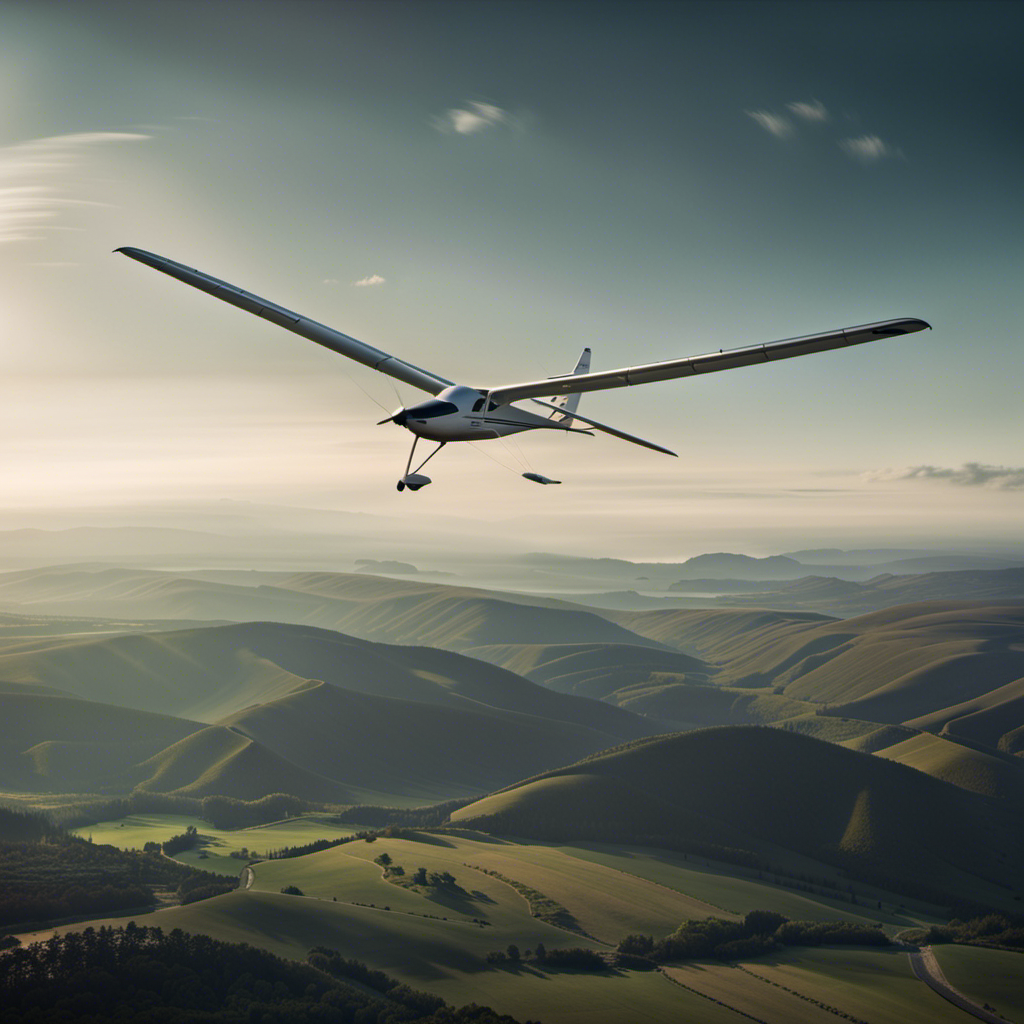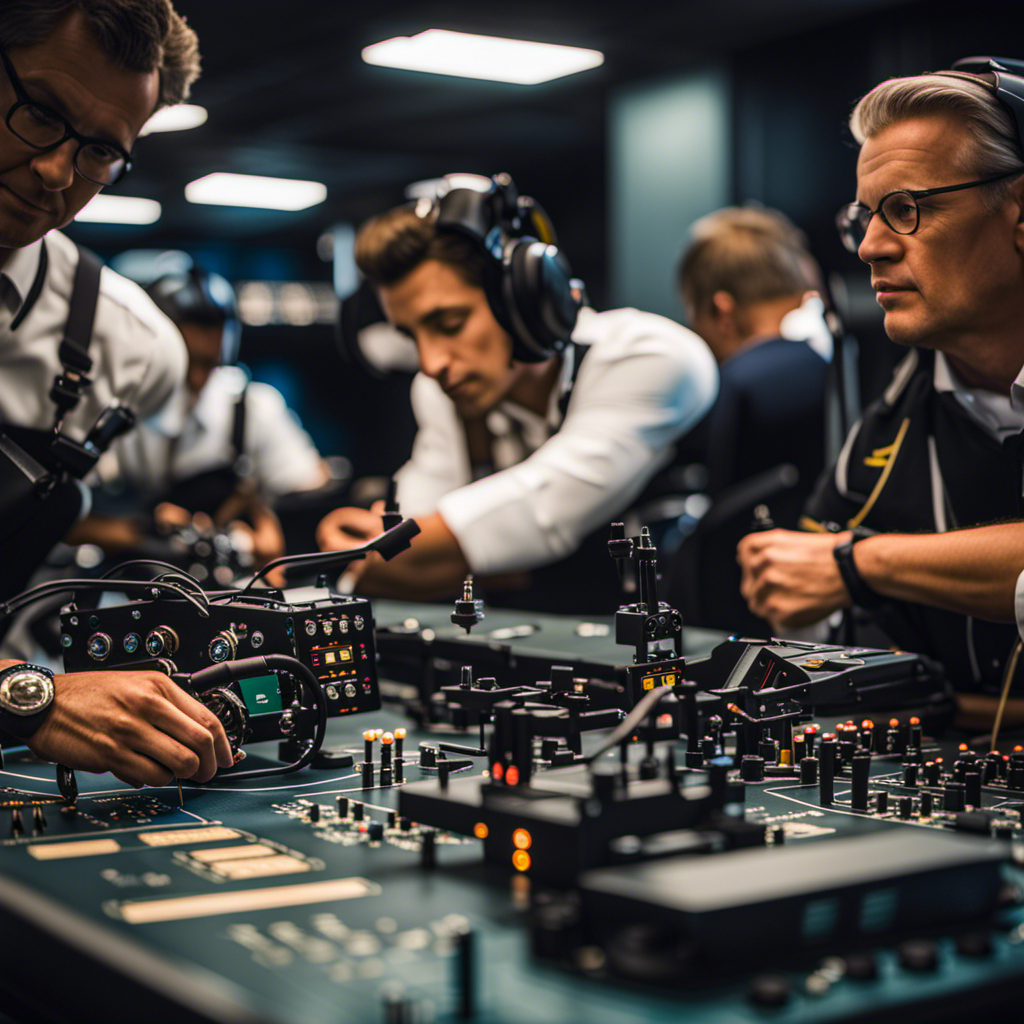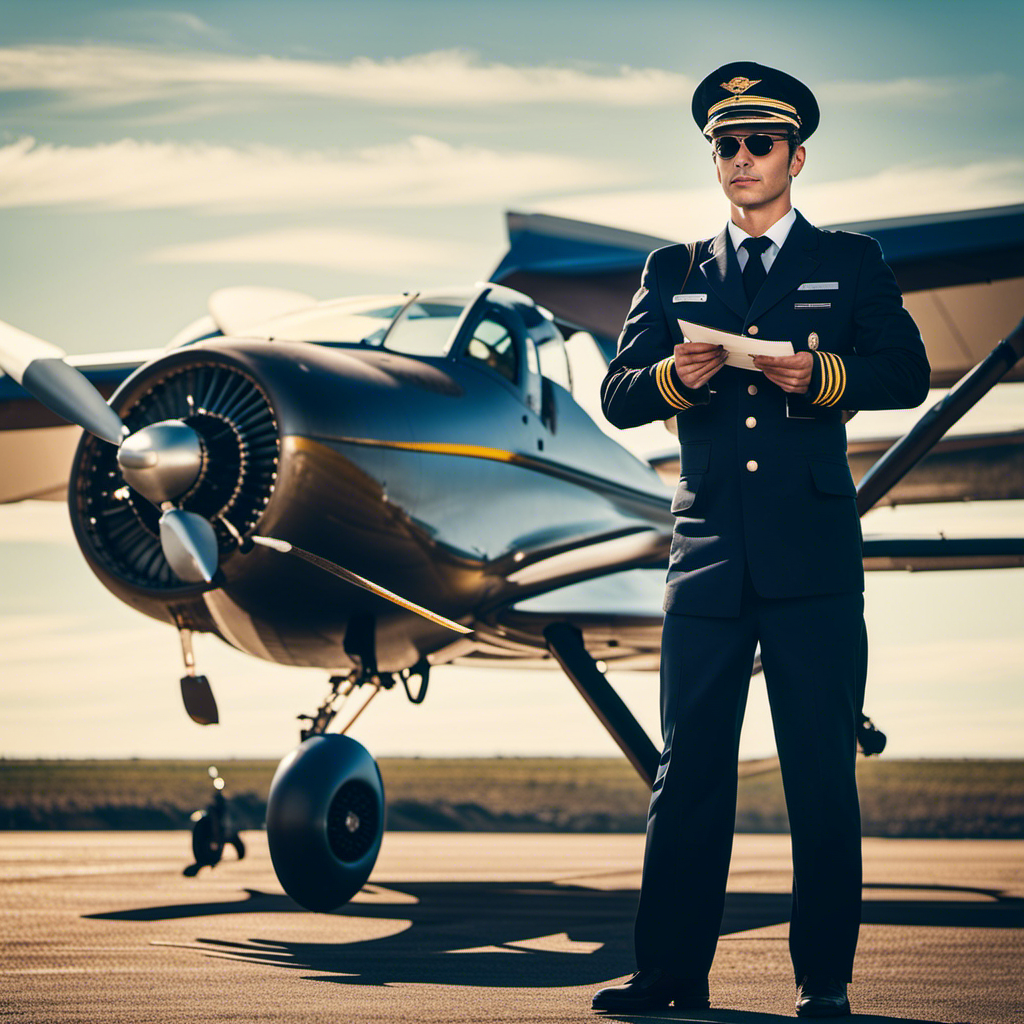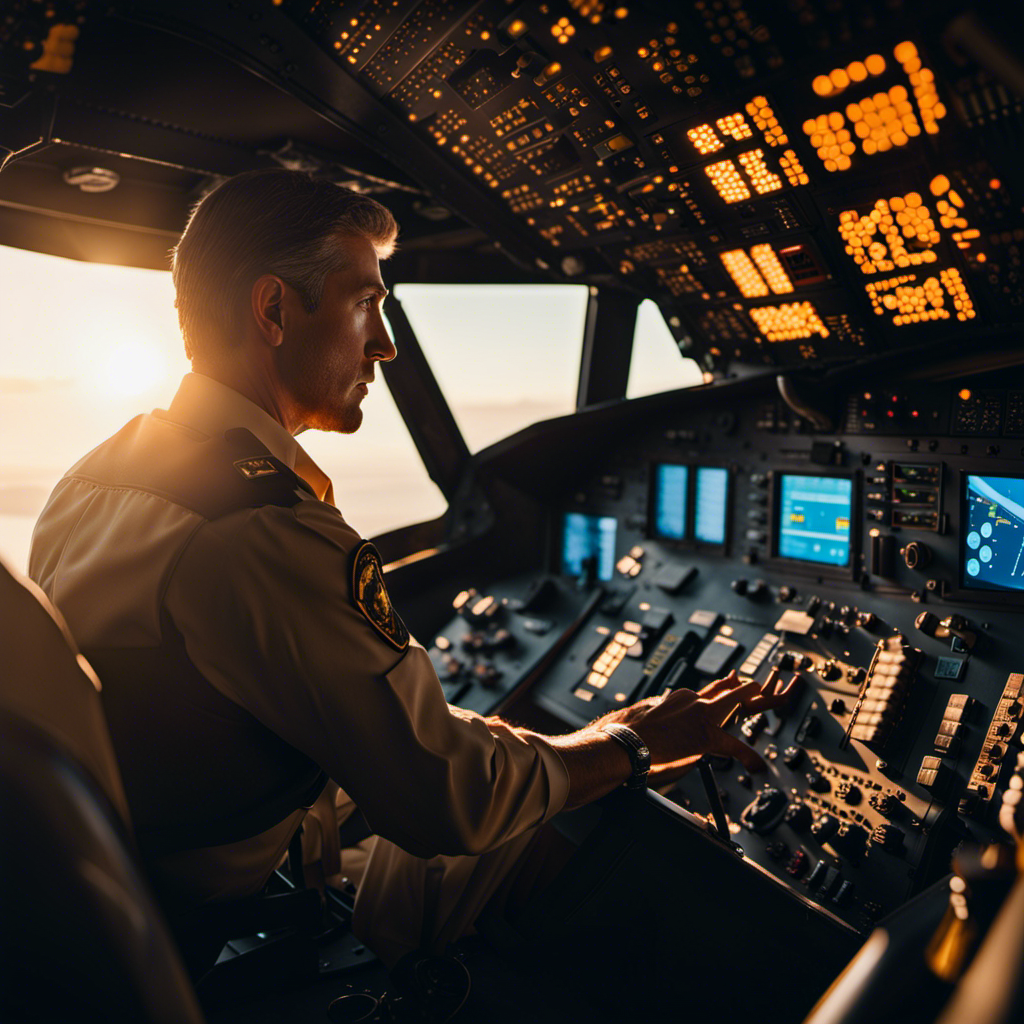Are you ready to take flight and experience the thrill of gliding through the air? You’ve come to the right place! In our detailed guide, we will show you everything you need to know to become a skilled glider pilot.
From the basics of gliding to advanced techniques and skills, we’ve got you covered. So, strap in and get ready for an exhilarating journey as we dive into the world of gliding and help you become a skilled glider pilot.
Key Takeaways
- Gliding is a type of engineless flight that relies on natural forces and requires training and practice.
- There are different types of gliders, including Standard Class, Open Class, Two-Seater, and Motorized Gliders, each suited for different flying styles and skill levels.
- Finding the right gliding club is crucial for starting your gliding journey, as they provide community, gliders, and training facilities.
- To obtain a glider pilot license, you must meet certain requirements, attend ground school and theory lessons, undergo flight training, and gain experience through solo check flights and building flight hours.
The Basics of Gliding
Before we get into the nitty-gritty of gliding, let’s start with the basics.
Gliding is a form of flight where an aircraft doesn’t have an engine and relies on natural forces to stay airborne. It’s an exhilarating experience that allows you to soar through the skies and feel the freedom of flight.
To start gliding, you’ll need to understand the principles of aerodynamics, the control surfaces of the glider, and how to read the weather conditions.
Learning to launch, steer, and land a glider requires training and practice, but it’s well worth the effort.
Once you’ve mastered the basics, you can delve into the different types of gliders and discover which one suits your flying style and preferences.
Types of Gliders
There are various types of gliders to choose from when starting out. Each type has its own unique features and capabilities, designed to suit different flying preferences and skill levels. Here are some popular options to consider:
-
Standard Class: These gliders have a wingspan of around 15 meters and are suitable for cross-country flights.
-
Open Class: With a wingspan up to 18 meters, these gliders are built for high-performance soaring and long-distance flights.
-
Two-Seater: Perfect for training purposes, these gliders accommodate an instructor and a student, allowing for dual controls.
-
Motorized Gliders: Equipped with an engine, these gliders can take off and climb independently, making them ideal for self-launching or flying in areas with limited access to a tow plane.
Now that you have a better understanding of the different types of gliders available, let’s explore how to find a gliding club.
Finding a Gliding Club
If you’re interested in joining a gliding club, the first step is to research clubs in your area. Gliding clubs offer a supportive community of pilots and access to gliders and training facilities. To help you in your search, here is a table showcasing three gliding clubs in different regions:
| Club Name | Location | Facilities Available |
|---|---|---|
| Sky Soarers | California | Gliders, Runway, Simulator |
| Cloud Chasers | New York | Gliders, Hangar, Clubhouse |
| Wind Riders | Texas | Gliders, Towing Aircraft |
Once you have identified potential clubs, visit their websites or contact them directly to gather more information about membership requirements, training programs, and fees. By finding the right gliding club, you will be one step closer to embarking on your gliding journey. In the next section, we will explore what it takes to get started in gliding.
Getting Started
To begin your journey towards becoming a glider pilot, you’ll first need to take an introductory flight. This will give you the opportunity to experience the thrill of gliding firsthand and determine if it’s the right fit for you.
Once you’re hooked, you can then proceed to attend ground school and theory lessons. Here, you’ll learn the essential knowledge and skills required for safe glider flying.
Taking an Introductory Flight
Before taking an introductory flight, it’s important to familiarize yourself with the basics of glider controls and safety procedures.
As a beginner, understanding the controls is crucial for a safe and enjoyable flight. The primary control surfaces of a glider include the ailerons, elevator, and rudder. The ailerons control the rolling motion, allowing you to bank the glider left or right. The elevator controls the pitch, helping you to climb or descend. The rudder controls the yaw, allowing you to turn the glider left or right.
Safety procedures are equally important. You must learn how to perform pre-flight checks, secure your harness properly, and locate emergency equipment.
Once you have a good grasp of these basics, you can confidently move on to attending ground school and theory lessons, where you will learn more about glider aerodynamics and flight principles.
Attending Ground School and Theory Lessons
Attending ground school and theory lessons is essential for gaining a deeper understanding of glider aerodynamics and flight principles. These lessons provide you with the necessary knowledge to become a competent glider pilot. Here are three key reasons why attending ground school is crucial:
- Learn about the different components of a glider and their functions.
- Understand the principles of aerodynamics and how they apply to glider flight.
- Study the rules and regulations governing glider operations.
By attending ground school and theory lessons, you will develop a solid foundation of knowledge that will enhance your flying skills and safety. This knowledge will also prepare you for the next step in your journey towards obtaining a glider pilot license.
Now, let’s explore the process of obtaining a glider pilot license and the requirements involved.
Obtaining a Glider Pilot License
Obtaining a glider pilot license requires meeting specific requirements and completing the necessary training. To help you understand the process, here is a breakdown of the requirements for obtaining a glider pilot license:
| Requirement | Description |
|---|---|
| Age | You must be at least 14 years old to start training for a glider pilot license. |
| Medical Fitness | You need to pass a medical examination to ensure you are physically fit to fly. |
| Ground School | Attending ground school and theory lessons is crucial to gaining the necessary knowledge about gliders and aviation regulations. |
Flight Training
Once you’re ready for flight training, you’ll start by learning the basics of glider operations. This phase of your training is crucial as it lays the foundation for your future flying endeavors.
You’ll become familiar with the glider’s controls, flight instruments, and pre-flight checks. The training will also cover important topics such as aerodynamics, weather analysis, and emergency procedures.
Your instructor will guide you through various flight maneuvers, teaching you how to take off, maintain altitude, and land safely. As you gain confidence and proficiency, you’ll progress to more advanced maneuvers like stall recovery and spins.
This initial training period is essential to ensure you have a solid understanding of glider operations before moving on to solo flying and progression into more challenging aspects of flying.
Solo Flying and Progression
When it comes to solo flying, there are three key points to consider: solo check flights, building flight hours and experience, and advancing to cross-country flying.
Solo check flights are an essential part of your training as they allow you to demonstrate your ability to safely operate the glider on your own.
Building flight hours and experience is crucial for developing your skills and confidence, as the more time you spend in the air, the better you become at handling different situations.
Solo Check Flights
Before taking your solo check flight, it’s important to thoroughly review the necessary safety procedures. This flight is a crucial step in your progression as a glider pilot.
During the solo check flight, you will be evaluated on your ability to safely operate the glider and handle various emergency situations. The check flight will typically include tasks such as takeoff, landing, circuit flying, and simulated emergency procedures.
It is essential to demonstrate your proficiency in these areas to ensure your readiness for solo flights. Once you successfully complete the check flight, you can proceed to building flight hours and gaining valuable experience.
This phase will involve flying under the supervision of an instructor or experienced pilot, allowing you to refine your skills and expand your knowledge of gliding.
Building Flight Hours and Experience
Now that you have successfully completed your solo check flights, it is time to focus on building flight hours and gaining valuable experience in flying a glider.
This phase of your training is crucial as it allows you to become more proficient in handling the aircraft and develop your decision-making skills.
During this period, you will fly with your instructor to practice various maneuvers, such as stalls, spins, and emergency procedures. Additionally, you will have the opportunity to explore different weather conditions and learn how to adapt your flying techniques accordingly.
As you accumulate more flight hours, you will become more comfortable and confident in the cockpit. This experience will serve as a solid foundation for advancing to cross-country flying, where you will embark on longer and more challenging flights, navigating unfamiliar territories and honing your navigation skills.
Advancing to Cross-Country Flying
As you accumulate more flight hours and gain valuable experience, you will have the opportunity to embark on longer and more challenging cross-country flights, honing your navigation skills and navigating unfamiliar territories. This stage of your glider training is crucial for developing your ability to plan, execute, and adapt to various flight scenarios.
Here are key aspects to consider as you advance to cross-country flying:
-
Flight planning:
-
Studying weather patterns and forecasts
-
Determining optimal routes and waypoints
-
Navigation techniques:
-
Using charts, GPS, and other navigational aids
-
Employing dead reckoning and pilotage methods
-
Emergency preparedness:
-
Identifying suitable emergency landing sites
-
Understanding emergency procedures and protocols
By mastering these skills, you will be well-equipped to explore new horizons and push the boundaries of your glider flying capabilities.
As you progress in your training, it is crucial to ensure that your glider is in top condition for safe and reliable flights. Therefore, let’s now delve into the important topic of glider maintenance and inspections.
Glider Maintenance and Inspections
When it comes to glider maintenance, there are certain basic tasks you need to perform regularly to keep your glider in top condition. These tasks include checking and replacing fluids, inspecting and cleaning the airframe, and ensuring proper tire pressure.
Routine inspections and checks are also crucial to identify any potential issues before they become major problems. These inspections should include a thorough examination of the control surfaces, landing gear, and electrical systems.
Basic Maintenance Tasks
Performing basic maintenance tasks on your glider is essential in order to keep it in good working condition. Regularly cleaning and inspecting your glider is the first step. Remove any dirt, debris, or insects from the exterior and check for any signs of damage or wear.
It’s important to lubricate the moving parts, such as the control surfaces and hinges, to ensure smooth operation. Additionally, check the tension of the control cables and adjust if necessary. Don’t forget to inspect the canopy for any cracks or tears and replace if needed.
Routine Inspections and Checks
To ensure the airworthiness of your glider, it’s important to regularly inspect and check various components. By conducting routine inspections and checks, you can identify any potential issues and address them before they become major problems.
Here are some key areas to focus on during your inspections:
-
Structural Integrity:
-
Examine the wings, fuselage, and tail for any signs of damage or wear.
-
Check the control surfaces for proper alignment and freedom of movement.
-
Inspect the landing gear and ensure it is in good condition.
-
Systems and Instruments:
-
Test all electrical systems and instruments for proper functionality.
-
Check the communication and navigation equipment for any issues.
-
Inspect the oxygen system and ensure it is working correctly.
-
Safety Equipment:
-
Confirm that the parachute and safety harnesses are in good condition.
-
Check the fire extinguisher and emergency locator transmitter.
By regularly performing these inspections and checks, you can ensure the airworthiness of your glider and maintain a safe flying experience.
In the next section, we will discuss additional steps to ensure the overall airworthiness of your glider.
Ensuring Glider Airworthiness
Now that you are familiar with routine inspections and checks, it is important to understand how to ensure the airworthiness of your glider.
Maintaining the airworthiness of a glider involves a series of steps that must be followed diligently. First and foremost, you must regularly inspect the structural integrity of the glider, paying close attention to any signs of wear or damage. It is crucial to examine the control surfaces, landing gear, and wings for any cracks or loose components.
Secondly, you should carefully review the glider’s maintenance records and ensure that all required inspections and service bulletins have been addressed. Additionally, it is essential to keep the glider clean and free from debris, as this can affect its performance.
By following these guidelines, you can ensure that your glider remains airworthy and ready for flight.
Next, let’s delve into advanced techniques and skills that will elevate your glider piloting abilities.
Advanced Techniques and Skills
In this section, you’ll delve into the realm of advanced techniques and skills in glider flying.
You’ll learn about the thrilling world of aerobatics and advanced maneuvers, where you’ll master precise control and execute impressive aerial feats.
Additionally, you’ll explore the art of thermal soaring and ridge soaring techniques, honing your ability to maximize lift and sustain flight.
Aerobatics and Advanced Maneuvers
Mastering aerobatics and advanced maneuvers in a glider requires practice and precision. As a pilot, you must be well-versed in the art of controlling the glider with finesse and confidence.
To execute aerobatic maneuvers such as loops, rolls, and spins, you need to understand the principles of flight dynamics and be able to manipulate the controls with accuracy. These maneuvers not only test your flying skills but also enhance your ability to handle unexpected situations in the air.
Once you have mastered these advanced techniques, you can then move on to exploring thermal soaring and ridge soaring techniques, which will allow you to stay aloft for extended periods and cover great distances without the need for a motor or external power source. By understanding the science behind these soaring techniques, you can harness the power of nature and soar like a bird through the sky.
Thermal Soaring and Ridge Soaring Techniques
Thermal and ridge soaring techniques allow you to stay aloft for extended periods without a motor or external power source. By utilizing these techniques, you can harness the power of the atmosphere to gain altitude and maintain flight.
Here are three key benefits of thermal and ridge soaring:
-
Increased flight time: By using thermals, which are columns of rising air created by the sun’s heating of the ground, you can stay airborne for hours, maximizing your flying experience.
-
Cost-effective flying: Gliders are more affordable to operate compared to powered aircraft, as you don’t have to worry about fuel costs or engine maintenance.
-
Eco-friendly: Gliders have a minimal impact on the environment, as they produce no emissions and operate silently, allowing you to enjoy the beauty of nature without disturbing it.
Mastering thermal and ridge soaring techniques sets the foundation for developing your navigation and cross-country flying skills.
Navigation and Cross-Country Flying Skills
To enhance your navigation and cross-country flying skills, it’s essential to understand how to read aeronautical charts and use instruments like GPS for effective route planning. Aeronautical charts provide crucial information about airspace, navigation aids, topography, and obstacles. By interpreting these charts, you can determine the best routes, identify potential hazards, and plan for fuel stops. Additionally, GPS technology has revolutionized navigation in aviation, providing real-time position information, altitude, groundspeed, and track. With GPS, you can accurately track your progress, navigate to waypoints, and calculate distances and times. Combined with aeronautical charts, GPS enhances your situational awareness, making cross-country flying safer and more efficient.
| Skill | Description | Importance |
|---|---|---|
| Reading charts | Understanding symbols, airspace classifications, and topographic data | High |
| Using GPS | Navigating to waypoints, tracking progress, and calculating distances | High |
| Route planning | Identifying hazards, choosing optimal routes, and planning fuel stops | High |
| Situational awareness | Monitoring position, altitude, and groundspeed in real-time | High |
| Time management | Estimating durations and planning for contingencies | Medium |
Mastering these skills will prepare you for the next section on participating in gliding competitions, where precise navigation and efficient route planning are crucial for success.
Participating in Gliding Competitions
When it comes to participating in gliding competitions, it is important to understand the different types of competitions that exist. There are various types, such as distance racing, speed racing, and precision landing competitions, each with its own set of rules and objectives.
Training for competitions involves honing your skills in areas like navigation, aerodynamics, and strategy, as well as practicing specific competition maneuvers.
To succeed in gliding competitions, it is essential to have a thorough understanding of the rules, develop strong flying techniques, and maintain focus and precision throughout each competition.
Types of Gliding Competitions
If you want to test your skills and compete against other glider pilots, there are various types of gliding competitions available for you to participate in. These competitions are a great way to challenge yourself and showcase your abilities in the world of gliding. Below is a table that outlines four common types of gliding competitions:
| Competition Type | Description |
|---|---|
| Cross-Country | In this competition, pilots navigate a pre-determined course, aiming to cover the longest distance possible. |
| Racing | Pilots compete against each other to complete a set course in the shortest amount of time. |
| Aerobatics | This competition focuses on performing precise and graceful maneuvers in the air. |
| Distance and Duration | Pilots aim to fly for the longest duration or cover the greatest distance within a specified time frame. |
Training for Competitions
For effective training, focus on developing your skills and practicing maneuvers specific to the type of gliding competition you want to participate in. Training for gliding competitions requires a combination of theoretical knowledge and practical experience.
Start by understanding the rules and regulations of the competition you’re targeting. Familiarize yourself with the specific tasks and scoring criteria.
Next, work on improving your flying skills through regular practice flights. Focus on techniques such as efficient thermalling, accurate speed control, and precise landings. Additionally, consider joining a gliding club or finding a mentor who can provide guidance and feedback.
Remember, mastering the basics is crucial before attempting more advanced maneuvers. By dedicating time and effort to your training, you’ll be better prepared to tackle the challenges of gliding competitions and increase your chances of success.
Now that you have a solid foundation in training for gliding competitions, let’s explore some tips for success in these events.
Tips for Success in Gliding Competitions
Now that you’ve got the basics down, let’s dive into some tips for acing gliding competitions.
To succeed in these high-stakes events, it’s crucial to focus on your strategy and execution. Firstly, study the competition tasks thoroughly, understanding the weather conditions and optimal routes.
During the race, prioritize energy management, using thermals efficiently and conserving momentum. Constantly analyze the sky, looking for signs of lift and areas to avoid. Sharpen your navigation skills, reading maps and using instruments to stay on track.
Practice precision landings, honing your ability to hit the target spot-on. Remember, consistency is key; maintain a steady pace and avoid unnecessary risks. By applying these techniques, you’ll increase your chances of victory and elevate your flying skills to new heights.
Now, let’s transition into the subsequent section about soaring adventures and experiences.
Soaring Adventures and Experiences
Are you ready to take your gliding experience to new heights?
In this discussion, we will explore the thrilling world of gliding expeditions and long-distance flights, where you can soar across vast distances and challenge your skills as a pilot.
We will also delve into the exciting realm of gliding holidays and destinations, where you can combine your passion for flying with breathtaking scenery and unique cultural experiences.
Lastly, we will uncover the joy of joining gliding events and festivals, where you can connect with fellow gliding enthusiasts, share in the excitement of friendly competitions, and celebrate the exhilaration of flight.
Get ready for an adventure like no other!
Gliding Expeditions and Long-distance Flights
Gliding expeditions and long-distance flights can be incredibly rewarding experiences. As you embark on these adventures, you will encounter a multitude of challenges and triumphs.
Gliding expeditions often involve flying across vast distances, testing your skills and endurance. You will learn to navigate varying weather patterns, optimize your glider’s performance, and make strategic decisions to ensure a successful journey.
Long-distance flights require meticulous planning, including selecting the right flight path, understanding wind patterns, and managing energy resources. These expeditions offer an opportunity to explore different landscapes, witness breathtaking views, and push the boundaries of your gliding abilities.
Transitioning to the next section, let’s now explore the incredible gliding holidays and destinations that await you, where you can further hone your skills and enjoy breathtaking flights.
Gliding Holidays and Destinations
As you explore the world of gliding holidays and destinations, you’ll discover breathtaking landscapes and thrilling flights that will leave you in awe. Gliding offers a unique way to experience the beauty of nature while soaring through the sky.
Here are three key aspects to consider when planning your gliding holiday:
-
Location: From the stunning alpine peaks of New Zealand to the vast plains of Argentina, there are countless destinations around the world that cater to gliding enthusiasts. Each location offers its own unique terrain and weather conditions, providing a diverse range of flying experiences.
-
Facilities: When choosing a gliding holiday, it’s important to consider the facilities available at the gliding club or resort. Look for well-maintained gliders, experienced instructors, and comfortable accommodation options to ensure a smooth and enjoyable experience.
-
Scenic Routes: Gliding holidays often offer the opportunity to fly over breathtaking landscapes such as mountains, coastlines, and forests. Research the available routes and choose ones that allow you to witness the most stunning scenery.
Joining Gliding Events and Festivals
When you attend gliding events and festivals, you’ll have the opportunity to connect with fellow enthusiasts and immerse yourself in the vibrant gliding community. These gatherings are not only a chance to showcase the latest gliding technology and techniques, but also a great platform for learning and sharing experiences. Here is a table that outlines some popular gliding events and festivals around the world:
| Event/Festival | Location | Date | Description |
|---|---|---|---|
| Oshkosh AirVenture | Oshkosh, Wisconsin, USA | July | The world’s largest aviation event, featuring glider displays and aerobatic performances. |
| Coupe Icare | Saint-Hilaire-du-Touvet, France | September | A colorful festival with paragliding and hang gliding demonstrations. |
| Australian International Airshow | Avalon, Victoria, Australia | February | A biennial event showcasing gliders, military aircraft, and aerobatic displays. |
| Interlaken Airshow | Interlaken, Switzerland | August | A breathtaking airshow set against the stunning backdrop of the Swiss Alps. |
Attending these events will not only allow you to witness thrilling displays of gliding prowess but also to network with experts in the field and gain insights into the latest advancements. So mark your calendar and get ready to be a part of the exhilarating gliding community.
Conclusion
In conclusion, you have now completed your comprehensive guide on learning to fly a glider. By gaining knowledge on the basics of gliding, exploring various types of gliders, finding a suitable gliding club, and undergoing flight training, you have embarked on a remarkable journey.
Remember, glider maintenance and inspections are crucial for safe flights, and mastering advanced techniques will elevate your skills. Additionally, participating in gliding competitions and seeking soaring adventures will provide you with thrilling experiences.
Did you know that gliding has a low accident rate, with only 8 accidents per million flights? This statistic showcases the emphasis on safety and the meticulous training in the gliding community.
So, go ahead and spread your wings, as the sky awaits your soaring endeavors.
Orion, better known as “Jetstream,” is the voice that brings the stories of the skies to life. His fascination with aviation began at a young age, sparked by his father’s tales of flying and adventure. Orion’s journey into the world of gliding was serendipitous, and from the moment he took his first glider flight, he knew he had found his calling.










